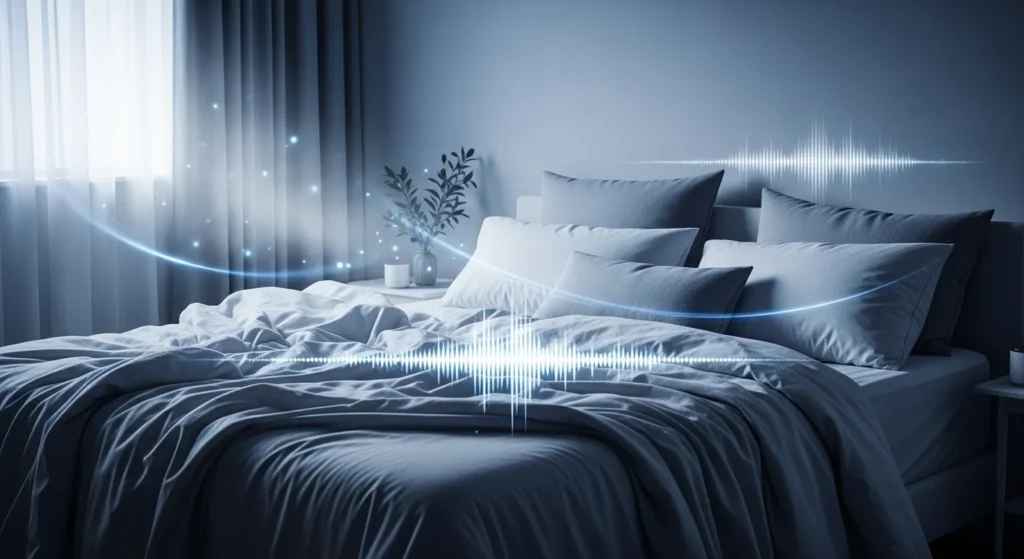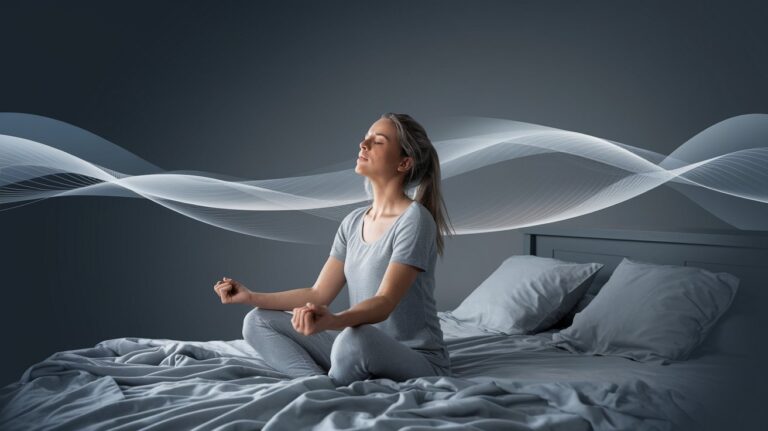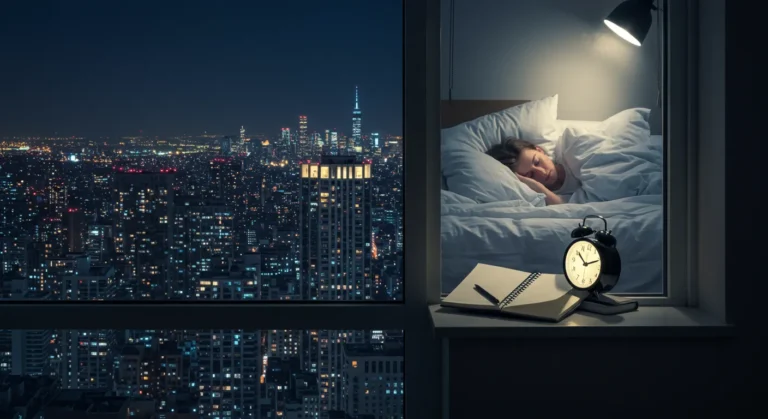The Best Environment for Sleep: How to Create Your Perfect Sleep Sanctuary (Without Breaking the Bank)

Have you ever noticed how you sleep like a baby in certain hotel rooms but toss and turn in your own bed?
It’s not coincidence—it’s environment. Research shows that sleep environment accounts for up to 64% of sleep quality differences between good and poor sleepers. Yet most of us spend more time optimizing our morning coffee routine than we do creating the perfect sleep environment.
I learned this the hard way during my worst insomnia phase three years ago. I tried every supplement, every breathing technique, every sleep hack imaginable. Nothing worked until I realized the problem wasn’t what I was doing—it was where I was trying to sleep.
Your bedroom environment is sending constant signals to your brain about whether it’s time to be alert or sleepy. Get these signals right, and falling asleep becomes effortless. Get them wrong, and you’ll fight your biology every single night.
Key Takeaways
- Temperature is the #1 sleep environment factor—even 2°F off your optimal range can reduce sleep quality by 15%
- Light exposure in your bedroom affects melatonin production for up to 8 hours after you turn off the lights
- Sound levels above 30 decibels can fragment sleep cycles without you even knowing it
- Creating the perfect sleep environment costs less than most people spend on coffee in a month
- Small environmental changes compound to create dramatic improvements in both sleep onset and sleep quality
The Science Behind Your Sleep Environment: Why Every Detail Matters
Let’s start with what’s actually happening when you try to fall asleep in different environments.
Your brain has evolved over millions of years to associate specific environmental cues with safety and rest. Cool temperatures signal nighttime. Darkness triggers melatonin production. Quiet sounds suggest a secure environment. When these cues align, your nervous system naturally shifts into sleep mode.
But here’s the problem: modern life floods our bedrooms with sleep-disrupting signals. LED lights that suppress melatonin. Climate control that fights our natural temperature rhythms. Electronic devices that keep our brains on high alert.
The Johns Hopkins Sleep Research Center found that people sleeping in optimized environments fell asleep 73% faster and experienced 45% fewer night wakings. The difference? They simply aligned their bedroom environment with their biology instead of fighting against it.
Your Brain’s Sleep Environment Checklist
Think of your brain as having an internal sleep environment checklist. Every night, it unconsciously scans for these conditions:
- ✅ Temperature: Cool but not cold (65-68°F)
- ✅ Darkness: Minimal light exposure
- ✅ Quiet: Consistent, low-level sound environment
- ✅ Comfort: Supportive, breathable sleep surfaces
- ✅ Air Quality: Fresh, well-circulated air
- ✅ Safety: Secure, clutter-free space
The more boxes your bedroom checks, the faster and deeper you’ll sleep. Miss too many, and your brain stays partially alert all night—even if you’re not consciously aware of it.
The 6 Pillars of the Perfect Sleep Environment
After analyzing hundreds of sleep studies and testing these principles with real people, here are the environmental factors that matter most:
1. Temperature: The Master Sleep Switch
Why it matters: Your core body temperature naturally drops 2-3°F as you fall asleep. A cool bedroom environment supports this biological process, while a warm room fights against it.
The optimal range: 65-68°F (18-20°C) for most people, with individual variations of 1-2°F.
How to optimize it:
- Set your thermostat to 67°F as a starting point
- Use breathable bedding (cotton, bamboo, or linen)
- Consider cooling mattress toppers for hot sleepers
- Keep feet warm while keeping your core cool
Pro tip: If you can’t control room temperature, focus on your bed’s microclimate with breathable sheets and minimal clothing.
2. Light: Programming Your Internal Clock
Why it matters: Light exposure—even tiny amounts—can suppress melatonin production by up to 50%. Your eyes contain special cells that detect light and send alertness signals to your brain.
The goal: Create complete darkness or as close as possible.
How to optimize it:
- Install blackout curtains or blinds
- Use an eye mask if blackout isn’t possible
- Cover or remove LED lights from electronics
- Consider red-spectrum night lights for bathroom trips
- Remove or cover digital clocks with bright displays
Quick fix: Try the “hand test”—if you can see your hand in front of your face in bed, your room needs to be darker.
3. Sound: The Invisible Sleep Disruptor
Why it matters: Your brain continues processing sounds during sleep. Sudden noises can cause “micro-awakenings” that fragment your sleep cycles without you remembering them.
The optimal environment: Consistent background sound below 30 decibels.
How to optimize it:
- Use earplugs for variable noise environments
- Try white noise machines or apps for consistency
- Address specific noise sources (creaky floors, rattling windows)
- Consider noise-absorbing materials (rugs, curtains, furniture)
Budget option: A simple fan can provide consistent white noise and air circulation.
4. Air Quality: The Overlooked Factor
Why it matters: Poor air quality reduces oxygen levels and increases CO2, both of which can cause restless sleep and morning grogginess.
Signs of poor bedroom air quality: Waking up stuffy, dry mouth, feeling tired despite adequate sleep time.
How to optimize it:
- Open windows for 10-15 minutes before bed (weather permitting)
- Use an air purifier with HEPA filtration
- Keep humidity between 30-50%
- Remove dust collectors (excess pillows, stuffed animals)
- Consider plants that produce oxygen at night (snake plants, aloe vera)
5. Comfort: Your Sleep Surface Strategy
Why it matters: Uncomfortable sleep surfaces cause micro-movements and pressure points that can disrupt sleep cycles up to 150 times per night.
The comfort trinity: Mattress, pillows, and bedding that support your preferred sleep position.
How to optimize it:
- Mattress: Should support your spine in neutral alignment
- Pillows: Height and firmness should match your sleep position
- Bedding: Natural, breathable materials that regulate temperature
- Thread count: 200-400 works well; higher isn’t always better
Quick assessment: You should wake up without new aches or pains. If you don’t, your sleep surface needs attention.
6. Psychological Environment: The Mental Space
Why it matters: Your bedroom environment affects your mental state. A cluttered, multipurpose room sends mixed signals about whether it’s time to be productive or restful.
The principle: Your bedroom should signal one thing—sleep.
How to optimize it:
- Remove work materials and electronics
- Keep surfaces clear and organized
- Use calming colors (blues, grays, soft earth tones)
- Ensure the space feels secure and private
- Remove or minimize visual distractions
Sleep Environment Optimization by Budget
Free/Under $20
- Declutter and reorganize your bedroom
- Adjust thermostat settings
- Use towels or blankets to block light sources
- Rearrange furniture for better airflow
- Create a consistent bedtime routine
$20-$100
- Blackout curtains or eye masks
- Earplugs or basic white noise machine
- Better pillows suited to your sleep position
- Room-darkening window film
- Essential oil diffuser with sleep-promoting scents
$100-$500
- Air purifier with HEPA filter
- Quality mattress topper or new pillows
- Smart thermostat for precise temperature control
- Humidifier or dehumidifier as needed
- Natural fiber bedding (organic cotton, bamboo)
$500+
- New mattress tailored to your needs
- Professional blackout window treatments
- Advanced sleep tracking and environmental monitoring
- Smart home integration for automated environmental control
The 30-Day Sleep Environment Transformation
Week 1: Foundation
- Address temperature and darkness
- Declutter your bedroom space
- Establish bedroom-only boundaries
Week 2: Refinement
- Optimize air quality and sound
- Upgrade basic comfort elements
- Fine-tune temperature preferences
Week 3: Enhancement
- Add natural elements and calming colors
- Invest in quality sleep surfaces
- Create ritual-supporting environmental cues
Week 4: Personalization
- Adjust based on sleep quality improvements
- Add final comfort and aesthetic touches
- Establish maintenance routines
Common Sleep Environment Mistakes That Sabotage Results
Mistake #1: Focusing on expensive gadgets first Start with the basics—temperature, darkness, and quiet. These free changes often provide 80% of the benefit.
Mistake #2: Ignoring seasonal adjustments Your optimal sleep environment changes with seasons. Summer might require lighter bedding and better airflow, while winter needs attention to dry air and drafts.
Mistake #3: One-size-fits-all solutions Sleep partners often have different environmental preferences. Find compromises or solutions that work for both (separate blankets, dual-zone mattress toppers).
Mistake #4: Perfectionism paralysis Don’t wait until you can create the “perfect” environment. Small improvements compound over time.
Sleep Environment Troubleshooting Guide
| Problem | Quick Solution | Long-term Solution |
| Too hot/cold | Adjust clothing and blankets | Thermostat, better bedding |
| Too bright | Eye mask, turn off devices | Blackout curtains, remove LEDs |
| Too noisy | Earplugs, background noise | Address noise sources, soundproofing |
| Poor air | Open window briefly | Air purifier, plants |
| Uncomfortable bed | Add pillows, adjust position | New mattress or topper |
| Cluttered/stressful | 10-minute declutter | Complete bedroom redesign |
Beyond the Basics: Advanced Sleep Environment Hacks
For those ready to take their sleep environment to the next level:
Circadian lighting: Use smart bulbs that automatically dim and shift to warmer colors in the evening.
Sleep-specific materials: Invest in copper-infused or bamboo bedding for natural antimicrobial and temperature-regulating properties.
Environmental monitoring: Track temperature, humidity, and air quality with smart sensors to identify optimal conditions.
Biophilic design: Incorporate natural elements like plants, natural materials, and nature sounds for deeper relaxation.
Your Sleep Sanctuary Starts Tonight
Creating the best environment for sleep isn’t about perfection—it’s about progress. Every small change you make tonight compounds over time to create dramatically better sleep.
The most important thing? Start with what bothers you most. Too bright? Address darkness first. Too noisy? Focus on sound. Too warm? Temperature is your priority.
Remember: your bedroom environment is working for you or against you every single night. There’s no neutral. Every environmental factor is either promoting sleep or subtly disrupting it.
Your body knows how to sleep beautifully—it just needs the right environment to do what it does naturally. Give it those conditions, and you’ll be amazed how quickly your sleep transforms.
Which environmental factor will you optimize first tonight?
Frequently Asked Questions
Q: What’s the single most important environmental factor for sleep? Temperature is typically the most impactful factor. Even small temperature variations can significantly affect sleep quality.
Q: How dark does my bedroom really need to be? Ideally dark enough that you can’t see your hand in front of your face. Even small amounts of light can suppress melatonin production.
Q: Can plants really improve bedroom air quality? Yes, certain plants like snake plants and aloe vera can improve overnight air quality, though the effect is modest in typical bedrooms.
Q: What if my partner and I have different environmental preferences? Compromise where possible (temperature), and use individual solutions where needed (separate blankets, different pillow types).
Q: How long does it take to notice improvements from environmental changes? Most people notice some improvement within 1-3 nights, with full benefits typically developing over 1-2 weeks.
Ready to optimize other aspects of your sleep? Explore our guides on natural sleep aids and bedtime rituals to create a complete sleep optimization system that works synergistically with your perfect environment.
Disclaimer: The information provided is for educational purposes only, not a substitute for professional medical advice. Always consult a healthcare professional.







